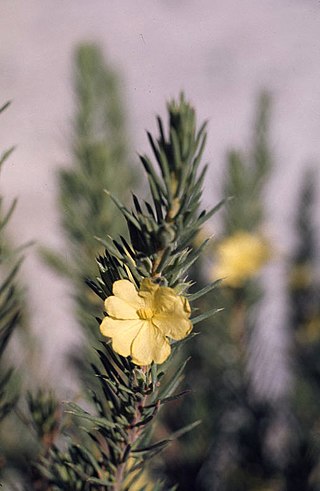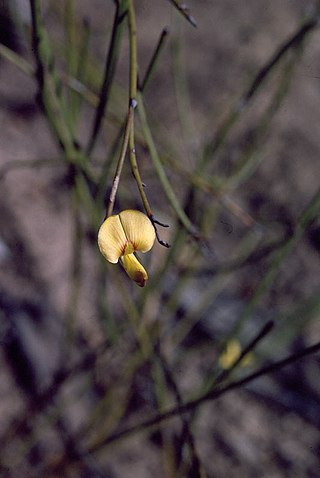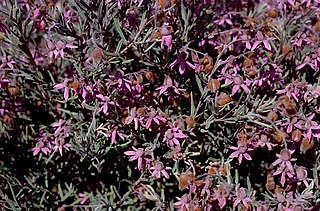Verticordia carinata, commonly known as pea-shaped featherflower or Stirling Range featherflower, is a flowering plant in the myrtle family, Myrtaceae and is endemic to Western Australia. It is an erect, spindly shrub with small, well-spaced leaves and pink and red flowers. It is a rarely seen plant, not known between its description in 1849 and its rediscovery in 1990.

Guichenotia macrantha, commonly known as large-flowered guichenotia, is a species of flowering plant in the family Malvaceae. It is a shrub with grey-green leaves, mauve flowers and is endemic to Western Australia.

Boronia pulchella, commonly known as the pink boronia, is a plant in the citrus family Rutaceae, and is endemic to a small area in the south-west of Western Australia. It is a slender shrub with rod-like stems, pinnate leaves and deep pink, four-petalled flowers.
Phebalium microphyllum is a species of small, rounded shrub that is endemic to Western Australia. It has scaly branchlets, leathery, oblong leaves, and yellow flowers arranged in umbels of three to six on the ends of branchlets.

Hibbertia mucronata is a species of flowering plant in the family Dilleniaceae and is endemic to the south of Western Australia. It is an erect shrub with hairy branches, crowded, thick, tapering linear leaves ending in a sharp point, and golden yellow flowers with five stamens fused at their bases, all on one side of two densely hairy carpels.
Bossiaea divaricata is a species of flowering plant in the family Fabaceae and is endemic to the southwest of Western Australia. It is a low, dense, openly-branched shrub with oblong to egg-shaped leaves and deep yellow and dark red flowers.

Daviesia anceps is a species of flowering plant in the family Fabaceae and is endemic to the south of Western Australia. It is a dense, erect or low-lying shrub with its branchlets reduced to flattened cladodes, and yellow flowers with red markings.

Daviesia crenulata is a species of flowering plant in the family Fabaceae and is endemic to the south-west of Western Australia. It is a bushy shrub with broadly egg-shaped phyllodes with a sharply-pointed end and wavy edges, and uniformly yellow-orange and maroon flowers.

Mirbelia subcordata is a species of flowering plant in the family Fabaceae and is endemic to the south-west of Western Australia. It is an erect, spreading shrub with egg-shaped to lance-shaped leaves and yellow or orange and red flowers.

Thomasia rhynchocarpa is a species of flowering plant in the family Malvaceae and is endemic to the Southwest Australia south-west of Western Australia. It is an erect, slender shrub with narrowly egg-shaped leaves with a heart-shaped base, and pink to purple flowers.

Thomasia rugosa, commonly known as wrinkled leaf thomasia, is a species of flowering plant in the family Malvaceae and is endemic to the south-west of Western Australia. It has wrinkled, lance-shaped to egg-shaped leaves with wavy edges, and pink to mauve flowers.

Thomasia stelligera is a species of flowering plant in the family Malvaceae and is endemic to the south-west of Western Australia. It is a low, spreading shrub with scattered, narrowly oblong leaves, and racemes of mauve flowers.
Androcalva cuneata is a species of flowering plant in the family Malvaceae and is endemic to the south-west of Western Australia. It is a low, spreading, densely hairy shrub that sometimes forms suckers and has wedge-shaped leaves and clusters of 5 to 15 pink flowers.

Commersonia densiflora is a species of flowering plant in the family Malvaceae and endemic to the south-west of Western Australia. It is a dense, low-growing shrub with pinnate, elliptic to narrowly oblong, prominently veined leaves, and white flowers in clusters of 100 or more.
Commersonia rotundifolia, commonly known as round-leaved rulingia, is a species of flowering plant in the family Malvaceae and endemic to the south-west of Western Australia. It is an upright, openly-branched shrub with elliptic to round leaves with wavy edges, and white flowers in clusters of 3 to 10.
Commersonia gilva, commonly known as golden commersonia, is a species of flowering plant in the family Malvaceae and is endemic to the south-west of Western Australia. It is an erect shrub with elliptic to oblong or egg-shaped leaves and yellow flowers.

Androcalva crispa, commonly known as crisped leaf commersonia, is a species of flowering plant in the family Malvaceae and is endemic to the south-west of Western Australia. It is a prostrate shrub that forms suckers from rhizomes and has densely new growth, clusters of lobed, egg-shaped or oblong leaves with wavy, serrated edges, and groups of white and pinkish-purple flowers.
Androcalva inglewoodensis is a species of flowering plant in the family Malvaceae and is endemic to south-eastern Queensland. It is a spreading, prostrate shrub that has hairy young branchlets, egg-shaped to elliptic leaves with irregularly serrated edges, and small groups of white to cream-coloured flowers.

Androcalva johnsonii is a species of flowering plant in the family Malvaceae and is endemic to central Queensland. It is a low, spreading shrub that has hairy young branches, narrowly egg-shaped or oblong leaves with rounded teeth, and small groups of white to pale pink flowers.
Androcalva pearnii is a species of flowering plant in the family Malvaceae and is endemic to the Blackdown Tableland National Park in eastern Queensland. It is shrub that forms suckers and has hairy new growth, wavy, oblong to elliptic leaves with rounded lobes on the edges, and groups of 3 to 8 white and cream-coloured to pale green flowers.












